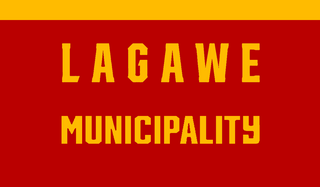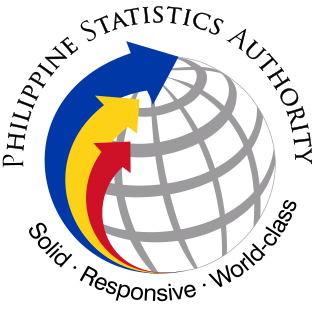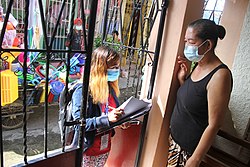
Demography of the Philippines records the human population, including its population density, ethnicity, education level, health, economic status, religious affiliations, and other aspects. The Philippines annualized population growth rate between the years 2015–2020 was 1.53%. According to the 2020 census, the population of the Philippines is 109,033,245. The first census in the Philippines was held in the year 1591 which counted 607,612 people.

Basco, officially the Municipality of Basco, is a 5th class municipality and capital of the province of Batanes, Philippines. In the 2020 census, it had a population of 9,517 people.

Kalayaan, officially the Municipality of Kalayaan, is a 3rd class municipality in the province of Laguna, Philippines. According to the 2020 census, it has a population of 24,755 people.

Asuncion, officially the Municipality of Asuncion, is a 1st class municipality in the province of Davao del Norte, Philippines. According to the 2020 census, it has a population of 61,893 people.

Salcedo, officially the Municipality of Salcedo, is a 4th class municipality in the province of Ilocos Sur, Philippines. According to the 2020 census, it has a population of 11,110 people.

Divilacan, officially the Municipality of Divilacan, is a 2nd class municipality in the province of Isabela, Philippines. According to the 2020 census, it has a population of 5,827 people.

Jalajala, officially the Municipality of Jalajala, is a 4th class municipality in the province of Rizal, Philippines. According to the 2020 census, it has a population of 34,017 people, making it the least populated municipality in the province.

Mendez, officially the Municipality of Mendez-Nuñez, is a 4th class municipality in the province of Cavite, Philippines. According to the 2020 census, it has a population of 34,879 people.

Buluan, officially the Municipality of Buluan, is a 4th class municipality and capital of the province of Maguindanao del Sur, Philippines. According to the 2020 census, it has a population of 57,406 people.

Bontoc, officially the Municipality of Bontoc, is a 2nd class municipality and capital of the province of Mountain Province, Philippines. According to the 2020 census, it has a population of 24,104 people.

Siayan, officially the Municipality of Siayan, is a 2nd class municipality in the province of Zamboanga del Norte, Philippines. According to the 2020 census, it has a population of 36,236 people.

Mabini, officially the Municipality of Mabini, is a 2nd class municipality in the province of Davao de Oro, Philippines. According to the 2020 census, it had a population of 43,552.

Tabuk, officially the City of Tabuk, is a 5th class component city and capital of the province of Kalinga, Philippines. According to the 2020 census, it has a population of 121,033 people.

Clarin, officially the Municipality of Clarin, is a 4th class municipality in the province of Misamis Occidental, Philippines. According to the 2020 census, it has a population of 39,356 people. Source: "clarinmisocc.gov.ph"

Alfonso Lista, formerly known as Potia, officially the Municipality of Lista is a 3rd class municipality in the province of Ifugao, Philippines. According to the 2020 census, it has a population of 34,061 people.

Lagawe, officially the Municipality of Lagawe is a 4th class municipality and capital of the province of Ifugao, Philippines. According to the 2020 census, it has a population of 18,876 people.

Plaridel, officially the Municipality of Plaridel, is a 5th class municipality in the province of Quezon, Philippines. According to the 2020 census, it has a population of 10,129 people.

Palayan, officially the City of Palayan, is a 5th class component city and capital of the province of Nueva Ecija, Philippines. According to the 2020 census, it has a population of 45,383 people, making it the least populated city in the Philippines.

The Philippine Statistics Authority is the central statistical authority of the Philippine government that collects, compiles, analyzes, and publishes statistical information on economic, social, demographic, political affairs, and general affairs of the people of the Philippines, as well as enforcing the civil registration functions in the country.

The 2015 Census of Population is the fourteenth census in the Philippines and is the first census conducted by the Philippine Statistics Authority.




















